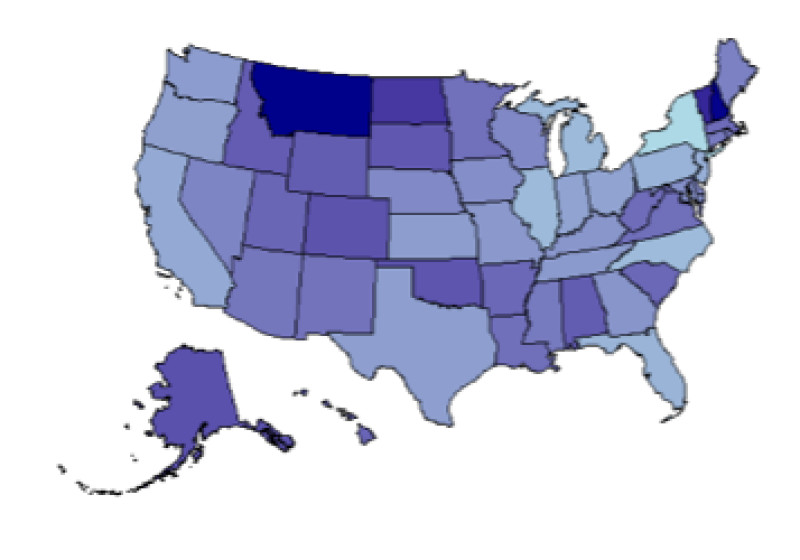
Emergency Medical Service (EMS) providers are employed by various types of agencies, each with slight differences in the provided emergency services. In 2020, a needs assessment conducted by the National Association of State EMS Officials identified 20,969 unique responding EMS agencies in the US.1 Figure 1 shows the number of EMS agencies in each state in 2020.
EMS agencies are often referred to as public or private. Public entities include fire and ambulance services that are government-funded. Some public agencies will not transport patients from the emergency scene to the hospital and will work with privatized companies to provide this service. In addition to providing transport services, private EMS agencies help increase EMS coverage and reduce response times. Private companies can be employed by hospital systems or for-profit agencies contracted by the municipality. Figure 2 shows the distribution of agency types among reported EMS agencies in 2020. Most documented EMS agencies are responsible for transporting patients from the scene of injury to the hospital; however, 32% of documented agencies provide pre-hospital care but do not transport patients. Less than 15% of EMS agencies provide specialty care. Ground specialty service agencies provide resources for interfacility transfers and critically ill patients. Air medical services are highly specialized agencies that treat patients in extreme environments or those too unstable to travel by ground.
The National Emergency Medical Services Information System (NEMSIS) is a national database that tracks EMS activations across the US and its territories. Between February 2nd, 2022-February 2nd, 2024, there were 109,664,253 EMS activations reported to NEMSIS.2 83% of all EMS activations requested an agency with transport capacity (Figure 3). Fire departments responded to 39% of activations and private EMS agencies were dispatched to 34% of the activations (Figure 4).
Hiring personnel in EMS agencies is an intricate and often complicated matter. A single EMS agency can employ various levels of EMS providers and both paid and unpaid (volunteer) staff. Volunteer staff are often in small rural areas. In these rural areas, volunteer and mixed agencies responded to 24% of all EMS activations compared to only 19% of activations in urban areas between February 2nd, 2022-February 2nd, 2024.2 For more information on the different levels of EMS licensure and career outlook among EMS personnel, check out our recently published article called “**”.
Figure 1: Number of Unique EMS agencies per state, 2020
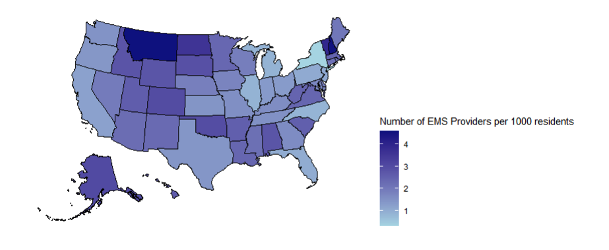
Data Source: National Registry of Emergency Medical Technicians and US Census Bureau
Figure 2: Number of EMS providers per 1000 residents, 2020
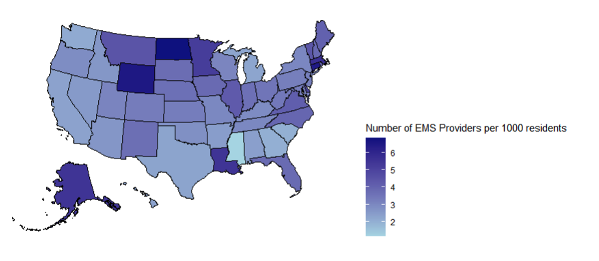
Data Source: 2020 National Emergency Medical Services Assessment and US Census Bureau
Figure 3: Reported level of licensure among certified EMS providers, 2020 (N=681,398)
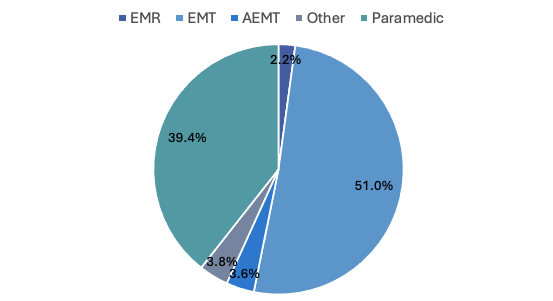
Data Source: 2020 National Emergency Medical Services Assessment
Figure 4: EMS agency types, 2020 (N=20,969)
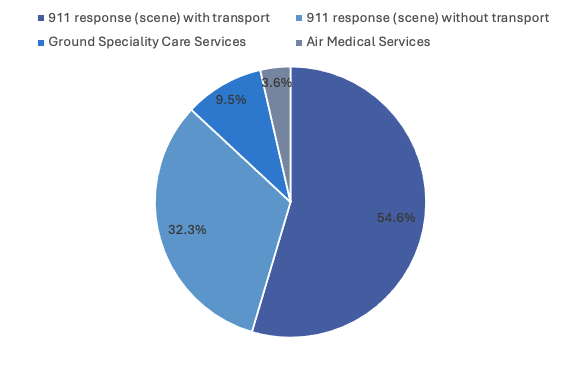
Data Source: 2020 National Emergency Medical Services Assessment
- 1. National Registry of Emergency Medical Technicians. About the National Registry. National Registry of Emergency Medical Technicians. Retrieved February 1st, 2024 from https://www.nremt.org/about/about-us https://www.nremt.org/about/about-us
- 2. National Registry of Emergency Medical Technicians. National Registry Data, Dashboard, & Maps. (Updated February 1st, 2024). National Registry of Emergency Medical Technicians. Retrieved February 1st, 2024 from https://www.nremt.org/maps https://www.nremt.org/maps
- 3. National Registry of Emergency Medical Technicians. Annual 2022 Report. (October 26, 2023). National Registry of Emergency Medical Technicians. Retrieved February 1st, 2024 from https://indd.adobe.com/view/4405972b-c580-46cd-9565-167a5cd9b62c https://indd.adobe.com/view/4405972b-c580-46cd-9565-167a5cd9b62c
- 4. 2020 National Emergency Medical Services Assessment. (May 27, 2020). National Association of State EMS Officials. Retrieved February 1st, 2024 from https://www.ruralcenter.org/sites/default/files/2020%20National%20EMS%20Assessment.pdf https://www.ruralcenter.org/sites/default/files/2020%20National%20EMS%20Assessment.pdf
- 5. US Bureau of Labor Statistics. Occupational Outlook Handbook: EMTS and Paramedics. (September 6, 2023). US Bureau of Labor Statistics. Retrieved February 1st, 2024 from https://www.bls.gov/ooh/healthcare/emts-and-paramedics.htm. https://www.bls.gov/ooh/healthcare/emts-and-paramedics.htm
- 6. US Bureau of Labor Statistics. Occupational Employment and Wages Statistics: Paramedics. (April 25th 2023). US Bureau of Labor Statistics. Retrieved February 1st, 2024 from https://www.bls.gov/oes/current/oes292043.htm#(3) https://www.bls.gov/oes/current/oes292043.htm#(3)
- 7. US Bureau of Labor Statistics. Occupational Employment and Wages Statistics: Emergency Medical Technicians. (April 25th 2023). US Bureau of Labor Statistics. Retrieved February 1st, 2024 from https://www.bls.gov/oes/current/oes292042.htm https://www.bls.gov/oes/current/oes292042.htm
- Dozens of courses and topics
- State-specific requirements
- We report to CAPCE in real time


